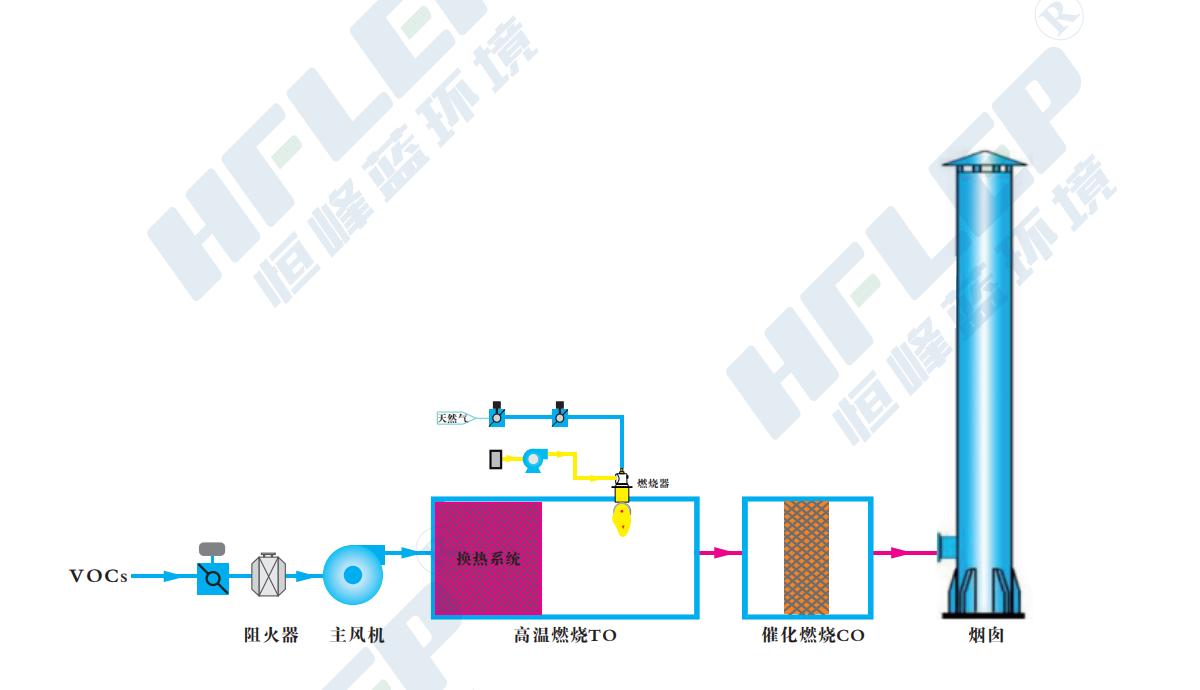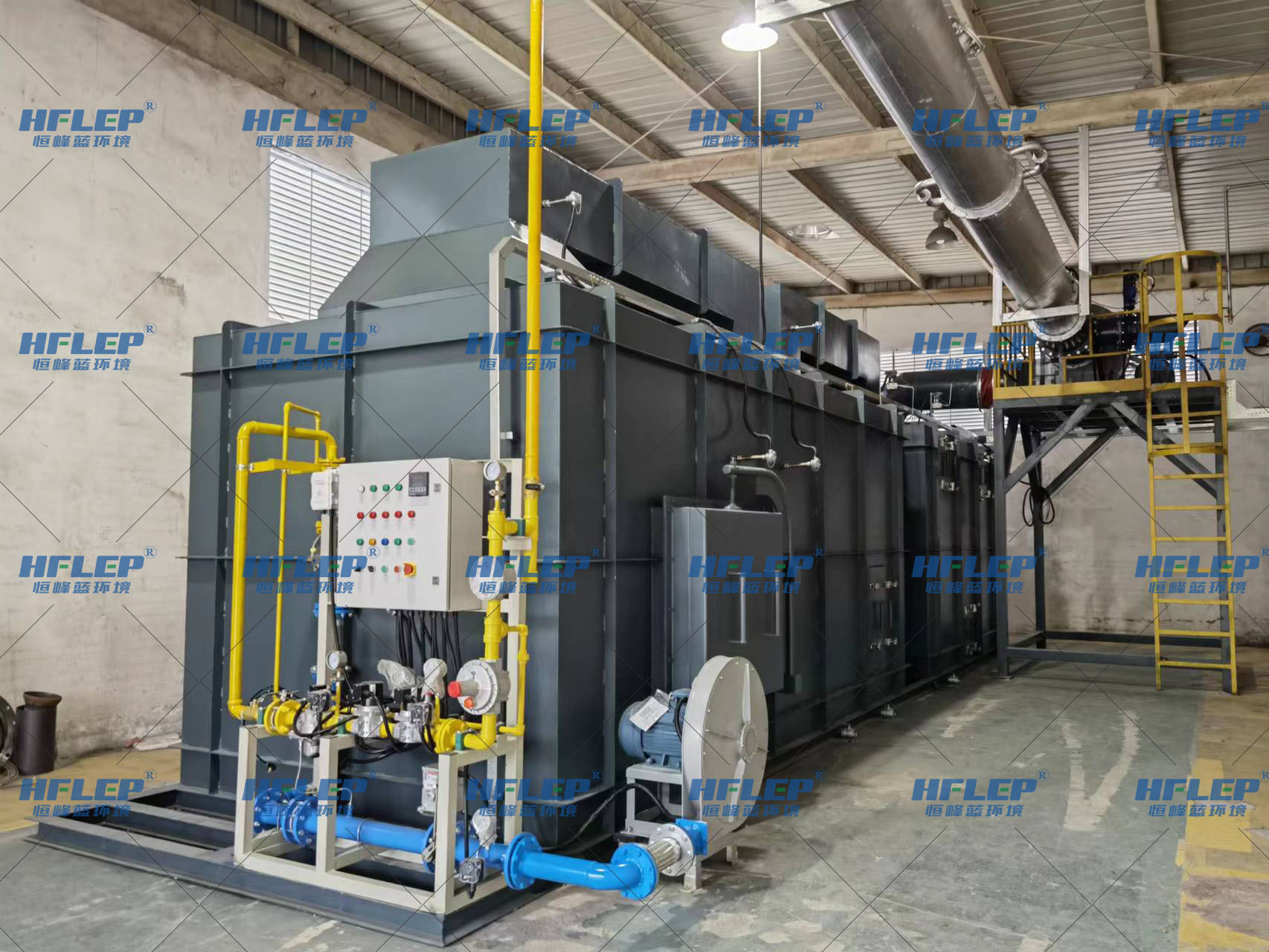Experienced Manufacturers
Production plant area of more than 10,000 square feet, more than 100 people construction team.
Message
86159 1875 6640CO catalytic combustion + TO direct combustion furnace process is a combination of co catalytic combustion equipment and TO direct combustion incinerator, mainly used for the treatment of waste gas containing silicon, can effectively prevent clogging, high safety factor. The process has an extremely wide range of applications, purification efficiency of 97% or more, can be heat reuse, reduce secondary pollution, energy saving!
CO catalytic combustion + TO direct combustion furnace process is a combination of co catalytic combustion equipment and TO direct combustion incinerator, mainly used for the treatment of waste gas containing silicon, can effectively prevent clogging, high safety factor. The process has an extremely wide range of applications, high purification efficiency, heat reuse, reduction of secondary pollution and energy saving!

CO catalytic combustion + TO direct combustion furnace process flow diagram
Working Principle
Organic waste gas is first pre-treated to remove most of the particles, and then warmed up through the heat exchange system, and then enter the TO furnace chamber to be decomposed into CO2 and H20 by high temperature (760 ℃ ~ 800 ℃), and at the same time release a large amount of heat to maintain the temperature of the furnace chamber. After incineration, the high-temperature exhaust gas is cooled down to about 350℃ by heat exchange, and then enters into the catalytic combustion furnace to further low-temperature catalytic combustion under the action of catalyst. After two stages of combustion, the organic waste gas is basically decomposed.
Silicone-containing organics are often found in paint and coating formulations and are often proprietary formulations that are not shown on the Material Safety Data Sheet (MSDS), as such silicone-containing organics do not affect the fire hazard or toxicity of such solvents and resins. Therefore, if a company uses RTO exhaust gas treatment equipment for organic exhaust gas treatment, it needs to research, analyse and test whether the component paints in the exhaust gas contain silicone-containing components. Silicone-containing organics are strictly prohibited from entering the RT0 exhaust gas treatment system, and some of the exhaust gases can also enter the RTO exhaust gas treatment system by replacing silicone-containing organics with non-silicone-containing organics. If the silicon-containing organic matter can not be replaced, it is not recommended to use RTO exhaust gas treatment system, you can choose not to use the heat storage ceramic body of the preheated combustion process, such as TO + CO (direct combustion exhaust gas combustion furnace).
Process characteristics
1、Energy-saving and environmental protection, high and stable processing efficiency.
2、Anti-clogging, easy to clean, especially suitable for silicon-containing waste gas.
3、Low consumables, low cost.
4、High degree of automation, a key start can be used.
5、It can reuse the heat energy and reduce the secondary pollution.
6、High safety coefficient and small floor space.
Scope of application
Automobile and parts manufacturing, hardware machinery manufacturing, furniture manufacturing, ink and paint manufacturing, printing, coating, pharmaceutical, chemical, PCB, semiconductor, electronics, toys, plastics, leather, shoes, rubber, textile printing and dyeing, and other industries, such as workshop generated by the large air volume of high-concentration VOC organic waste gas treatment.
Exhaust gas content contains: benzene, toluene, xylene, triphenylene, styrene, strange, alcohol, ether, phenol, ketone, ester, and other VOCs.
Related cases

Reason For Choice

Production plant area of more than 10,000 square feet, more than 100 people construction team.

A number of engineers and technicians, most of whom have more than 10 years of experience and have worked on numerous projects.

Adoption of the latest domestic and international treatment technology, with high treatment efficiency.

According to the actual needs of the project, free to customise the corresponding exhaust gas treatment solutions, all regions of the country package to meet the emission standards.

Passed the third level of construction enterprise qualification and a number of technical patents...

1000+ project experience, more than 100 industry partners, complete environmental protection qualification.
Contact - Ways
Contact information
Catalytic combustion machine is a dry filter + adsorption de...

Activated carbon adsorption and desorption + CO catalytic co...

Zeolite rotor concentration + RTO regenerative incinerator c...

Zeolite rotor concentration + CO catalytic combustion proces...

CO catalytic combustion + TO direct combustion furnace proce...

For low concentration and low air volume of waste gas treatm...

CO catalytic combustion + TO direct combustion furnace process is a combination of co catalytic combustion equipment and TO direct combustion incinerator, mainly used for the treatment of waste gas containing silicon, can effectively prevent clogging, high safety factor. The process has an extremely wide range of applications, high purification efficiency, heat reuse, reduction of secondary pollution and energy saving!

CO catalytic combustion + TO direct combustion furnace process flow diagram
Working Principle
Organic waste gas is first pre-treated to remove most of the particles, and then warmed up through the heat exchange system, and then enter the TO furnace chamber to be decomposed into CO2 and H20 by high temperature (760 ℃ ~ 800 ℃), and at the same time release a large amount of heat to maintain the temperature of the furnace chamber. After incineration, the high-temperature exhaust gas is cooled down to about 350℃ by heat exchange, and then enters into the catalytic combustion furnace to further low-temperature catalytic combustion under the action of catalyst. After two stages of combustion, the organic waste gas is basically decomposed.
Silicone-containing organics are often found in paint and coating formulations and are often proprietary formulations that are not shown on the Material Safety Data Sheet (MSDS), as such silicone-containing organics do not affect the fire hazard or toxicity of such solvents and resins. Therefore, if a company uses RTO exhaust gas treatment equipment for organic exhaust gas treatment, it needs to research, analyse and test whether the component paints in the exhaust gas contain silicone-containing components. Silicone-containing organics are strictly prohibited from entering the RT0 exhaust gas treatment system, and some of the exhaust gases can also enter the RTO exhaust gas treatment system by replacing silicone-containing organics with non-silicone-containing organics. If the silicon-containing organic matter can not be replaced, it is not recommended to use RTO exhaust gas treatment system, you can choose not to use the heat storage ceramic body of the preheated combustion process, such as TO + CO (direct combustion exhaust gas combustion furnace).
Process characteristics
1、Energy-saving and environmental protection, high and stable processing efficiency.
2、Anti-clogging, easy to clean, especially suitable for silicon-containing waste gas.
3、Low consumables, low cost.
4、High degree of automation, a key start can be used.
5、It can reuse the heat energy and reduce the secondary pollution.
6、High safety coefficient and small floor space.
Scope of application
Automobile and parts manufacturing, hardware machinery manufacturing, furniture manufacturing, ink and paint manufacturing, printing, coating, pharmaceutical, chemical, PCB, semiconductor, electronics, toys, plastics, leather, shoes, rubber, textile printing and dyeing, and other industries, such as workshop generated by the large air volume of high-concentration VOC organic waste gas treatment.
Exhaust gas content contains: benzene, toluene, xylene, triphenylene, styrene, strange, alcohol, ether, phenol, ketone, ester, and other VOCs.
Related cases
